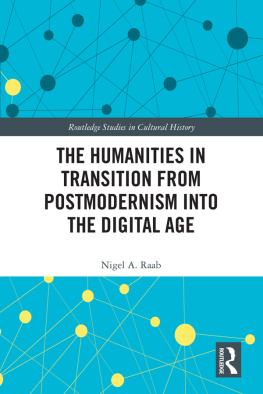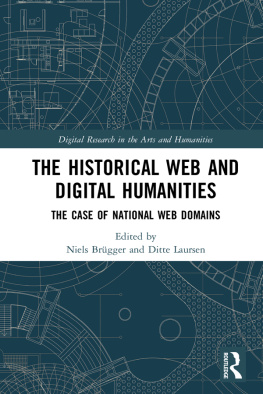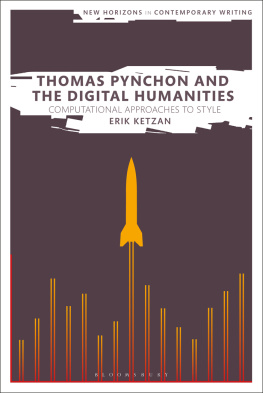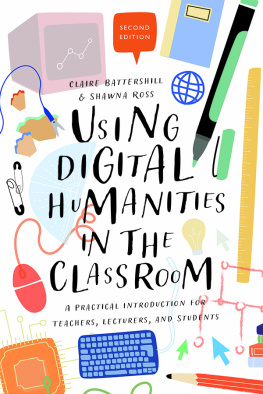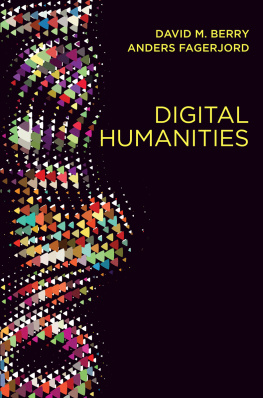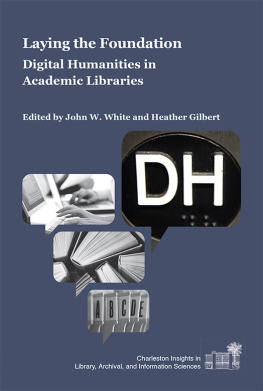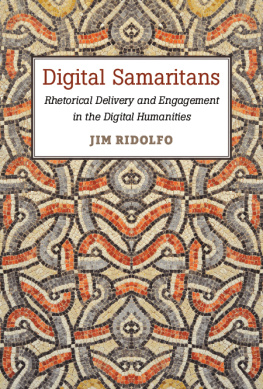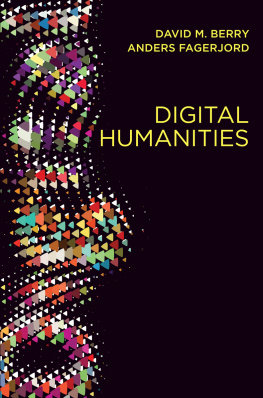Patrik Svensson - Big Digital Humanities: Imagining a Meeting Place for the Humanities and the Digital
Here you can read online Patrik Svensson - Big Digital Humanities: Imagining a Meeting Place for the Humanities and the Digital full text of the book (entire story) in english for free. Download pdf and epub, get meaning, cover and reviews about this ebook. year: 2018, publisher: University of Michigan Press, genre: Politics. Description of the work, (preface) as well as reviews are available. Best literature library LitArk.com created for fans of good reading and offers a wide selection of genres:
Romance novel
Science fiction
Adventure
Detective
Science
History
Home and family
Prose
Art
Politics
Computer
Non-fiction
Religion
Business
Children
Humor
Choose a favorite category and find really read worthwhile books. Enjoy immersion in the world of imagination, feel the emotions of the characters or learn something new for yourself, make an fascinating discovery.
- Book:Big Digital Humanities: Imagining a Meeting Place for the Humanities and the Digital
- Author:
- Publisher:University of Michigan Press
- Genre:
- Year:2018
- Rating:4 / 5
- Favourites:Add to favourites
- Your mark:
- 80
- 1
- 2
- 3
- 4
- 5
Big Digital Humanities: Imagining a Meeting Place for the Humanities and the Digital: summary, description and annotation
We offer to read an annotation, description, summary or preface (depends on what the author of the book "Big Digital Humanities: Imagining a Meeting Place for the Humanities and the Digital" wrote himself). If you haven't found the necessary information about the book — write in the comments, we will try to find it.
Patrik Svensson: author's other books
Who wrote Big Digital Humanities: Imagining a Meeting Place for the Humanities and the Digital? Find out the surname, the name of the author of the book and a list of all author's works by series.
Big Digital Humanities: Imagining a Meeting Place for the Humanities and the Digital — read online for free the complete book (whole text) full work
Below is the text of the book, divided by pages. System saving the place of the last page read, allows you to conveniently read the book "Big Digital Humanities: Imagining a Meeting Place for the Humanities and the Digital" online for free, without having to search again every time where you left off. Put a bookmark, and you can go to the page where you finished reading at any time.
Font size:
Interval:
Bookmark:


Patrik Svensson
University of Michigan Press
Ann Arbor
Page iv Copyright 2016 by Patrik Svennson
Some rights reserved

This work is licensed under the Creative Commons Attribution-Noncommercial-No Derivative Works 3.0 United States License. To view a copy of this license, visit http://creativecommons.org/licenses/by-nc-nd/3.0/ or send a letter to Creative Commons, 171 Second Street, Suite 300, San Francisco, California, 94105, USA.
Published in the United States of America by the
University of Michigan Press
A CIP catalog record for this book is available from the British Library.
Library of Congress Cataloging-in-Publication data has been applied for.
ISBN 978-0-472-07306-1 (hardcover : alk. paper)
ISBN 978-0-472-05306-3 (paper : alk. paper)
ISBN 978-0-47212174-8 (e-book)
http://dx.doi.org/10.3998/dh.13607060.0001.001
Page vThis is a book about how the humanities intersects with the digital. This engagement is richly multifaceted, intersectional, technical, critical, and hopeful. The digital can be seen as a material or a property that permeates much (but not all) of contemporary culture and society as well as the humanities as an institutional and scholarly endeavor. Humanistic questions about materiality, embodiment, prosthesis, gender, identity, privacy, space, aesthetics, and ethnicity all relate to the digital in one way or another, and such questions must shape the digital humanities. Some of these questions will necessarily be discipline-specific, while others will require joint efforts across disciplines and areas. At the same time, the humanities needs to engage with technology and maintain its critical potential when creating technological infrastructure. The technology itself is intertwined with instrumentation, methodologies, expert competence, expressions, research challenges, and analytical possibilities. Examples include map-based analyses, critical readings of databases, visualization, textual analysis, and academic installations.
The status of the digital humanities as a field has been debated for decades but now seems to have reached a certain size, level of maturity and level of visibility. At the same time, the digital humanities is still being formed, negotiated, and envisioned, which makes this a particularly good time to explore the field in depth. Disciplinary and epistemic tension exists, as do multiple possible paths forward, making this book not just a discussion of an existing field but also a far-reaching engagement with the ideational and practical shaping of that field, not in a dogmatic or exclusionary way but rather in an exploratory and inclusive fashion. This is also a book about how individual students, experts, and scholars can become involved in making the digital humanities.
One of the key challenges for the digital humanities is the integration of critical and technological engagement. For example, this requires humanists to look critically at big data as a phenomenon while considering how big data Page viii methodology may or may not be useful to humanities research and education. This may prompt the humanities to redefine what big data is and even to develop new methodologies. The bigness of big data in the humanities may refer to the number of perspectives inherent in the material and the richness of critical inflection rather than the sheer quantity of data.
In addition, the digital humanities has also come to be seen as a site for challenging and renewing the humanities and academy. This is a controversial position open to attack on several fronts. Some of the digital humanities community would state that envisioning the future of the humanities is not what the field is about given its focus on building and on managing day-to-day project works. Some mainstream humanists would argue that the digital humanities is not a serious humanistic endeavor because it simply includes too little humanities. Others would point out that digital humanities is a top-down strategy implemented by administrators and other leaders to help the humanities even though many other investments would make much more sense.
At the same time, the digital humanities has actually become a place of hope, open debate, and progressive energy, with strong critical potential. There is value to the debate and frenzy surrounding the digital humanities. Early career scholars are coming to the field not just because there may be jobs there but also because it is seen as a place to engage with the future of the humanities. And what if we see the support for the digital humanities not as a way of controlling and helping the humanities but rather as a possible way to strengthen both the humanities and the digital humanities? I see embracing this aspect of the digital humanities as a responsibility, and we need to incorporate all of these facets in our vision of the digital humanities. I also believe that we will likely reach a decisive point for the field in the near future and that some of the choices we make over the next five years will not only decide the fate of the digital humanities but influence the future of the humanities and the academy.
This book suggests a model for the digital humanities (big digital humanities) that draws on the humanities; on being placed in the space between ideas and institutions; on the traditions and emerging configurations of the digital humanities; and on the coming together of intellectual and technological curiosity. Many of the pieces are already there, and I hope that this volume will help us think about what we are, where we could be going, and how we can get there.
Page ixThere are many indications of the contemporary reach and energy of the digital humanities as a field. One simple example is that at the end of the first week of December 2013, at least three international workshops on the field took place simultaneously. The conference Cultural Research in the Context of Digital Humanities in St. Petersburg, Russia, coincided with the workshop Sorting the Digital Humanities Out in Ume, Sweden, and the conference (Digital) Humanities RevisitedChallenges and Opportunities in Hanover, Germany. These events demonstrate that the digital humanities also lives outside the Anglo-American sphere. The titles alone also give us a sense of the ongoing reconfiguration, and the event programs point to different directions and interests. It is also telling that the key international organization for the digital humanities, the Alliance of Digital Humanities Organizations, did not support any of these events, even though the Hanover conference included many speakers from that community.
As these gatherings demonstrate, the digital humanities is not one thing, and although the fields footprint has increased over the past decade, it does not incorporate everything that could be labeled digital humanities. Furthermore, not everyone who might be identified as doing digital humanities may want to be labeled a digital humanist. In this sense, the field is not a blank slate but rather a narrative or a series of narratives. As an institutional structure, the field has a predominant (and privileged) epistemic tradition that has shaped many of the institutional parameters that now configure it. This tradition, humanities computing, has a substantial investment in engaging with information technology as a tool, in privileging textual analysis and encoding, and in promoting a particular set of technologies and methodologies. These are important competencies and areas, but they are not the only ones. The recent expansion of the field, however, has challenged this structure on a number of points, which is a healthy and necessary development. For example, the perceived lack of gender, ethnic, or environmental engagement has been noted. Ideally, in intersecting with other traditions and disciplinary backgrounds, these areas will also be challenged and negotiated. For example, we see exciting development in areas such as environmental humanities and sound studies.
Font size:
Interval:
Bookmark:
Similar books «Big Digital Humanities: Imagining a Meeting Place for the Humanities and the Digital»
Look at similar books to Big Digital Humanities: Imagining a Meeting Place for the Humanities and the Digital. We have selected literature similar in name and meaning in the hope of providing readers with more options to find new, interesting, not yet read works.
Discussion, reviews of the book Big Digital Humanities: Imagining a Meeting Place for the Humanities and the Digital and just readers' own opinions. Leave your comments, write what you think about the work, its meaning or the main characters. Specify what exactly you liked and what you didn't like, and why you think so.



